Introduction
The coronavirus (‘COVID-19’) pandemic has set off a chain of events that, in our view, could lead to the largest global distressed credit1 cycle in a generation. What started off as a regional health issue in China has rapidly evolved to affect health-care systems globally, shutting down schools, transportation and financial markets and resulting in unprecedented monetary and fiscal responses from economies all over the world.
These recent economic and market conditions are creating pricing dislocations in sovereign and corporate credit. We believe these dislocations could provide a rare opportunity for distressed debt strategies, whose business model is built around stepping in to provide liquidity and restructure unsustainable balance sheets during these types of environments. Recent pricing moves indicate that default rates could be set to spike on a very large and potentially vulnerable global debt stack, which may create an attractive opportunity set for distressed debt strategies, particularly those focused on opportunities outside the US.
Coronavirus: The Spark That Ignited the Meltdown …
Data emerging from countries battling the COVID-19 pandemic presage surges in requirements for urgent medical care that are above most nations’ existing capacities. The pandemic has prompted global measures on testing, travel restrictions, social distancing and increased medical capacity to help control the pandemic’s propagation. These measures have, in turn, sparked an unprecedented, sudden and simultaneous collapse in both global supply and demand for a large swathe of goods and services constituting the vast majority of global GDP – from travel and tourism, to energy and commodities, to services and manufactured goods of almost all kinds.
Exacerbating the volatility was a dispute between heavyweight OPEC+ oil producers Russia and Saudi Arabia about sharing production cuts in response to the pandemic. This has intensified a steep drop in oil prices, which are now below most sovereign oil producers’ current fiscal breakeven points. The market is trying to comprehend the possible magnitude and duration of this shock, while also trying to anticipate possible reverberations and amplifications in unemployment, mortgage and corporate defaults, financial institution defaults, sovereign defaults and currency crises.
Although uncertainty and fear currently pervades financial markets, we believe it is important not to lose sight of some encouraging facts. Data from countries with higher testing indicate that the mortality rate of this virus appears to be relatively small once propagation rates are controlled. The same exponential math that explains the massive recent surge in cases in uncontrolled environments dictates that effective measures in controlling the propagation rate should dramatically cut the number of infections and deaths. The realistic prospect of vaccines, treatments, herd immunity and adaptation during prior pandemics suggest that global supply and demand, in particular for essential goods and services, should revert to more normal levels over time.
… A Meltdown Fuelled by Historic Debt Build-Up
The build-up in credit markets that preceded this pandemic sets the stage for what could be an enormous distressed debt cycle, particularly outside the US. Fuelled by historically low interest rates and investors’ desperate search for yield, the stock of corporate and sovereign debt grew significantly since the Global Financial Crisis. In the US, the high yield bond market grew by c. 80% between 2009 and 2019 to reach USD1.5 trillion.2 The market outside the US grew at a significantly faster rate to USD1.9 trillion. European high yield bonds and leveraged loans have more than doubled in size to USD0.5 trillion over the same period (Figure 1) and, in the emerging markets (‘EM’), high yield (‘HY’) Eurobonds from corporate and sovereign issuers topped USD1.4 trillion, more than triple their size in 2009 (Figure 2). During most of this period, defaults remained at historically low rates, and a relatively small pool of debt trading at distressed prices was mainly comprised of fundamentally weaker companies, countries and sectors.
Figure 1. European Loans and HY Bond Stock
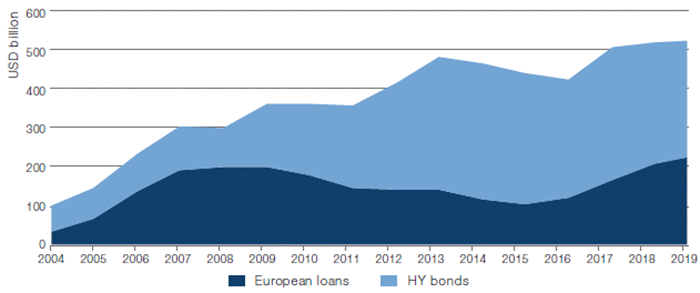
Source: S&P LCD European All Loans Index and ICE BofA ML Euro High Yield Index. Numbers are for face value as of 30 September 2019.
Figure 2. External EM HY Bond Stock
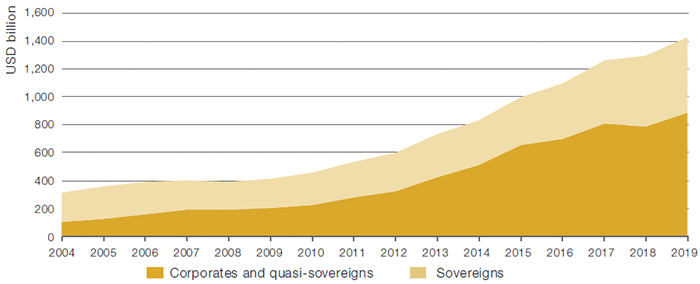
Source: JP Morgan research; face values as of 31 December 2019.
A Sudden Turn in Distressed Debt
The picture has now changed dramatically.
In the two weeks to 19 March, distressed debt in the US doubled to USD500 billion3, with the average yield on the entire US high yield index reaching ‘distressed’ levels.4 In Europe, as of 20 March, the volume of a high yield index trading at distressed levels jumped to USD109 billion5, or 28% of the index, a sharp rise from approximately 3% in mid-February (Figure 3). In EM, the equivalent index comprising sovereign and corporate bonds had USD349 billion6 trading at ‘distressed’ levels, representing a jump from approximately 15% of the index to 43% over the same period (Figure 4).
An initial screen of the wider universe points to an even greater distressed debt stock of USD764 billion as of 20 March, comprising of USD320 billion of EM sovereign, USD302 billion of EM corporate and USD142 billion of European corporate bonds (excluding financial institutions).7
This suggests a dramatic rise in upcoming defaults. Indeed, default rates in the US are expected to triple to 10% over the next 12 months and to quadruple in Europe to high single digits, according to S&P.8 While the agency has not yet made a prediction for EM, pricing there also points to a precipitous rise in default rates.
Figure 3. Bloomberg Barclays Pan European High Yield Index
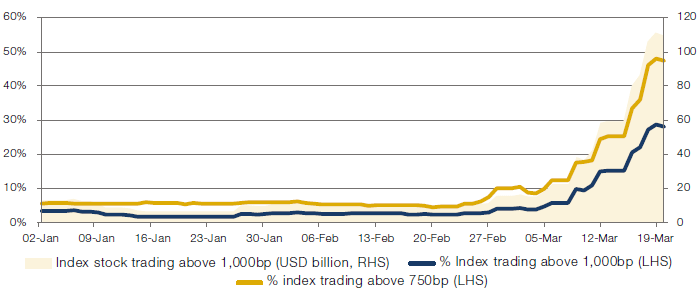
Source: Bloomberg; as of 20 March 2020.
Figure 4. Bloomberg Barclays EM High Yield Index
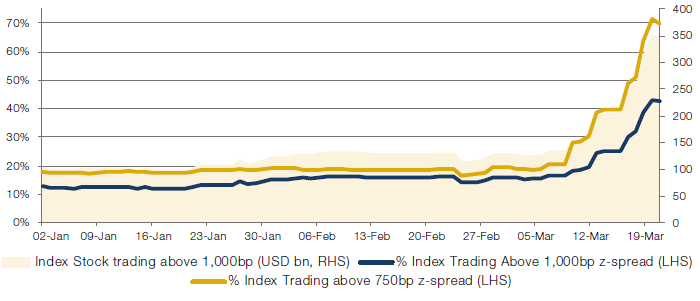
Source: Bloomberg; as of 20 March 2020.
Supply / Demand Imbalance Could Generate Greatest Opportunity Outside the US
We believe the amount of dedicated distressed investment capital available to meet this jump in supply of distressed or defaulted debt may prove to be insufficient, especially in markets outside of the US. From 2012 to 2019, managers raised c. USD200 billion for distressed credit, of which approximately two-thirds was destined for the US (Figure 5). The shallow pool of distressed debt investment opportunities during this period resulted in deployment of dedicated capital into a relatively small number of crowded investments into weaker borrowers often clustered around certain industries (e.g. retail, marginal oil production).
As of June 2019, dry powder for investment in distressed debt stood at USD60 billion in the US, whereas European funds held only USD17 billion of dry powder and dedicated EM distressed funds a scant USD5 billion.9 This could lead to increased activity in strategies focused on this space.
Figure 5. Total Funds Raised by Primary Geographic Focus
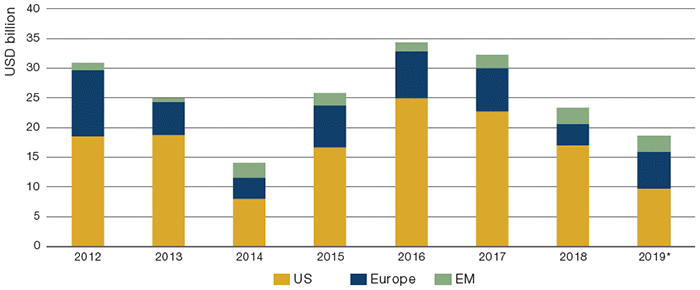
Source: Preqin. * Data for 2019 is through to 30 June 2019.
Figure 6. Dry Powder and Invested Capital
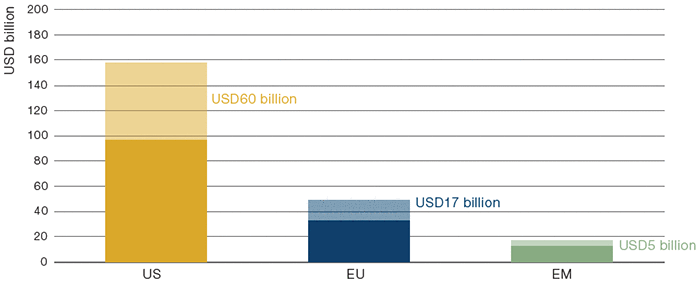
Source: Preqin; as of 30 June 2019. Dry powder illustrated by shaded region, invested capital illustrated by opaque region.
Notwithstanding the increased activity that might follow, the stark imbalance between the supply of distressed debt and the demand from dedicated investment capital in the US and internationally may well become even more acute. The larger US distressed debt managers, many of whom have smaller operations in Europe, are likely to prioritise the expanded opportunity set in their home market. Local European firms could similarly be susceptible to home bias as local opportunities increase and competition from their US peers decreases.
As larger managers retreat into their home markets, the imbalance could be most stark in emerging markets outside of Europe. Here, the debt stack of internationally traded hard-currency bonds and loans, largely held by international real money investors, has grown extremely rapidly (Figure 2). In contrast, the size of the dedicated distressed investment capital pool and, importantly, specialised investing and restructuring expertise has remained miniscule (Figure 6).
High-Quality Issuers Are Vulnerable in Emerging Markets
Although US investors tend to think of international credit markets, and EM in particular, as more opaque and risky, the classification of what are ‘emerging’ and ‘developed’ markets is an artificial and sometimes misleading construct.
International markets are home to systemically important or bottom-quartile cash cost producers of internationally traded essential goods. Many of these borrowers boast longstanding issuance histories in international markets, and compare favourably, in our view, to weaker high yield issuers in developed markets such as the US. During periods of dislocation and mispricing, these higher-quality borrowers can fall victim to untimely funding shutdowns that can force them into debt re-profiling.
In the current market, for example, an intense ‘flight to safety’ has caused wild swings in currencies, which has choked off companies and countries that rely on dollar debt funding and can’t print dollars or otherwise embark on quantitative easing-style bailout programs to help support their debt funding requirements.
Conclusion
The coronavirus pandemic has devolved into a global health and financial crisis that could yield a vast number of distressed credit situations, creating at an expanded opportunity set for distressed debt investors globally for three reasons. First, this crisis puts at risk a very large global debt stack that has been growing rapidly since the Global Financial Crisis, particularly outside of the US. Secondly, there is a significant imbalance between the expected supply of distressed and defaulted debt and the pool of dedicated capital and managers with relevant international experience, especially in emerging markets. Lastly, the opportunity set for international distressed credit could lead to investment opportunity due to higher-quality borrowers needing to restructure.
1. Using a common metric, debt is considered to be trading at distressed levels when yields are in excess of 1,000 basis points over the risk-free rate. More generally, distressed credit is fixed income securities trading at a substantial discount to original par value. This is generally debt of borrowers that are experiencing financial or operational distress and is in default or at risk of being in default. Distressed debt investing typically involves buying bonds and loans at distressed prices and restructuring those securities into new sustainable debt, equity and other types of instruments. Distressed debt managers ultimately realise gains or losses by selling these instruments or having them repaid.
2. Source: LCD (S&P); as of 31 December 2019.
3. Source: Bloomberg; Distressed Debt in U.S. Doubles to USD500 Billion in Two Weeks; 19 March 2020.
4. Source: Bloomberg; US Junk Bonds Enter Distress, Spreads Top 1,000 Basis Points; 21 March 2020.
5. Based on analysis of the Bloomberg Barclays Pan European High Yield Index. Data sourced from Bloomberg.
6. Based on analysis on the Bloomberg Barclays EM High Yield Index. Data sourced from Bloomberg.
7. Source: Bloomberg. Screening criteria restrict the universe to hard currency (USD, EUR, GBP, CHF) bonds trading at or greater than a yield to maturity of 10%, excluding financial institutions and issuances with less than USD200 million outstanding. 8. Source: S&P COVID-19 credit update on 17 March 2020.
9. Source: Preqin; as of 30 June 2019.
You are now leaving Man Group’s website
You are leaving Man Group’s website and entering a third-party website that is not controlled, maintained, or monitored by Man Group. Man Group is not responsible for the content or availability of the third-party website. By leaving Man Group’s website, you will be subject to the third-party website’s terms, policies and/or notices, including those related to privacy and security, as applicable.